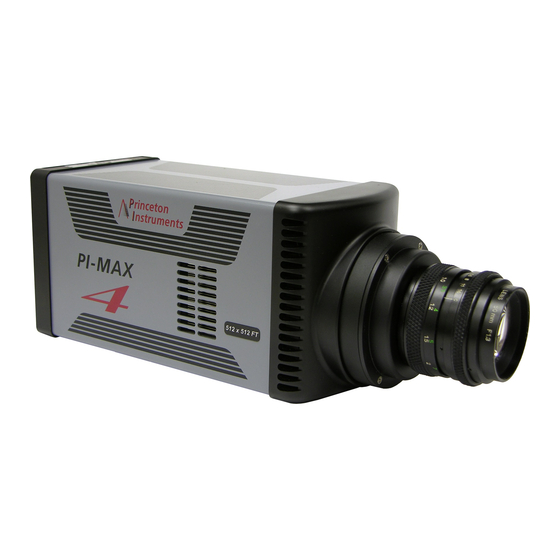
Princeton Instruments PI-MAX4 Manuals
Manuals and User Guides for Princeton Instruments PI-MAX4. We have 1 Princeton Instruments PI-MAX4 manual available for free PDF download: Manual
Princeton Instruments PI-MAX4 Manual (326 pages)
Camera System
Brand: Princeton Instruments
|
Category: Security Camera
|
Size: 14 MB
Table of Contents
-
Precautions
25 -
Repairs
26 -
-
Circulator42
-
-
-
Assumptions
49 -
Focusing
54
-
-
-
Assumptions
55 -
-
Focusing
60
-
-
Exposure
68 -
-
Digitization
83 -
-
Gating
97 -
-
Alarms
98
-
Timing Mode
99 -
Experiments
104 -
Gating
125 -
-
Intensifier Mode
126 -
Alarms
127
-
-
Timing Mode
127 -
-
Configuration
131
-
Experiments
132-
-
Spectrograph136
-
-
Pulse Set
153 -
Single Sequence
154 -
Time Stamping
155 -
Requirements
157 -
Trigger Setup
159-
Trigger Response
159 -
Trigger Source
160
-
-
-
Tips and Tricks
171 -
Requirements
173 -
Timing Modes
174 -
-
-
Tips and Tricks
186 -
Gain Variation
189 -
Timing
193 -
-
Requirements
197 -
Trigger Response
197 -
Gating Mode
198-
Repetitive198
-
Sequential200
-
Custom202
-
-
-
-
Enabling EM
219 -
Emiccd Gain Mode
220
-
Kinetics
224-
Masking
224 -
Trigger Sources
226 -
Data Readout
228 -
Binning
228 -
Cleaning the CCD
233
-
-
Photon Detection
236 -
-
Signal Delay
242 -
Lasers
245-
Triggered Lasers
245
-
Lens Performance
246-
Throughput
246 -
Depth of Field
246 -
Jitter
246
-
-
Baseline Signal
247 -
Temperature Lock
247 -
Mount Adapters
249 -
-
Aux I/O
251 -
AUX out
251 -
Coolant Ports
251 -
Error LED
252 -
Fan
252 -
Gig-E
252 -
Logic out
253 -
Monitor
253 -
Power Connector
253 -
Ready out
253 -
Trigger in
254
-
Coolcube
255 -
Cables
255 -
Tubing
255 -
User Manuals
257 -
-
AUX I/O Cable
272
-
Coolcube
286 -
-
Installation
293 -
Removal
293
-
-
Accessory Kits
305 -
Adapter Kits
305 -
-
Limited Warranty317
-
-
Index
321
Advertisement
Advertisement
Related Products
- Princeton Instruments PI-MAX System
- Princeton Instruments PI-MAX2 System
- Princeton Instruments ProEM+ EMCCD
- Princeton Instruments ProEM+:512B
- Princeton Instruments ProEM+:512BK
- Princeton Instruments ProEM+:1024B
- Princeton Instruments PhotonMAX System
- Princeton Instruments Roper Scientific PG-200
- Princeton Instruments PIXIS System
- Princeton Instruments PI-MAX 3 System
